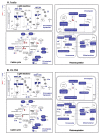Overexpression of Water-Responsive Genes Promoted by Elevated CO2 Reduces ROS and Enhances Drought Tolerance in Coffea Species
- PMID: 36834624
- PMCID: PMC9966387
- DOI: 10.3390/ijms24043210
Overexpression of Water-Responsive Genes Promoted by Elevated CO2 Reduces ROS and Enhances Drought Tolerance in Coffea Species
Abstract
Drought is a major constraint to plant growth and productivity worldwide and will aggravate as water availability becomes scarcer. Although elevated air [CO2] might mitigate some of these effects in plants, the mechanisms underlying the involved responses are poorly understood in woody economically important crops such as Coffea. This study analyzed transcriptome changes in Coffea canephora cv. CL153 and C. arabica cv. Icatu exposed to moderate (MWD) or severe water deficits (SWD) and grown under ambient (aCO2) or elevated (eCO2) air [CO2]. We found that changes in expression levels and regulatory pathways were barely affected by MWD, while the SWD condition led to a down-regulation of most differentially expressed genes (DEGs). eCO2 attenuated the impacts of drought in the transcripts of both genotypes but mostly in Icatu, in agreement with physiological and metabolic studies. A predominance of protective and reactive oxygen species (ROS)-scavenging-related genes, directly or indirectly associated with ABA signaling pathways, was found in Coffea responses, including genes involved in water deprivation and desiccation, such as protein phosphatases in Icatu, and aspartic proteases and dehydrins in CL153, whose expression was validated by qRT-PCR. The existence of a complex post-transcriptional regulatory mechanism appears to occur in Coffea explaining some apparent discrepancies between transcriptomic, proteomic, and physiological data in these genotypes.
Keywords: ABA signaling; ROS; coffee; functional analysis; stress; tolerance.
Conflict of interest statement
The authors declare no conflict of interest.
Figures








References
MeSH terms
Substances
Grants and funding
LinkOut - more resources
Full Text Sources

